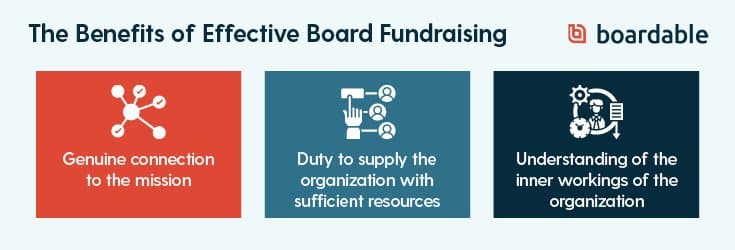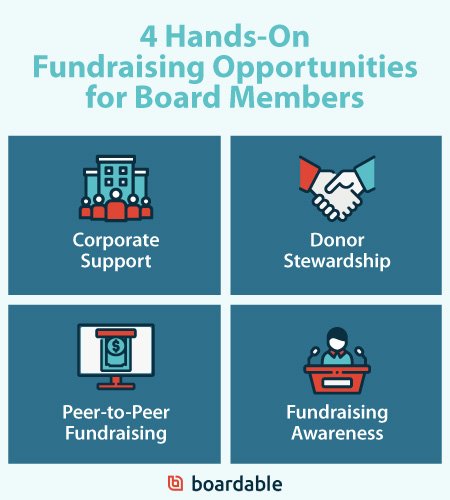
Guest post by Jeb Banner, CEO of Boardable
Your board members might not be the first team members that come to mind when you think of your nonprofit’s fundraising champions. After all, you likely have a development team that’s solely focused on pushing your fundraising initiatives forward. But board members can actually play a significant role in growing your organization’s campaigns.
Not only can board members contribute their own funds to your cause, but they can also leverage their personal and professional networks to strengthen your donor outreach strategies. When you establish fundraising as an expectation at the beginning of each board member’s term, you can lay a strong foundation for improved fundraising results.
In this guide, we’ll take a closer look at the best strategies and opportunities to engage your board in fundraising. Here’s what to expect:
-
Setting Fundraising Expectations for Board Members
-
4 Hands-On Fundraising Opportunities for Board Members
According to Boardable’s guide to nonprofit board fundraising, board members make exceptional fundraisers because their motivations for helping your nonprofit are genuine and altruistic. As volunteers, they’re inspired by nothing more than a simple desire to see your mission succeed and improve the community.
Plus, they have a firsthand understanding of how your organization works, meaning they have more context for how their actions support your fundraising efforts. This graphic highlights all of the benefits of involving board members in fundraising:

The strategies we’ll review will help harness these motivations to give board members an additional outlet to express their support.
Setting Fundraising Expectations for Board Members
To establish fundraising as a central component of your board’s activities, it’s important to set expectations early on in each individual’s term. This way, there are no surprises when new board members start in their roles and are expected to engage in fundraising activities.
Many board members are used to discussing fundraising within the boardroom, as your board plans fundraising events and creates an annual fundraising strategy. But some might not feel as comfortable with the hands-on aspects of nonprofit fundraising, such as soliciting donations.
Even veteran board members can use a helping hand every once in a while to approach their fundraising tasks more effectively. To create a culture of fundraising amongst your board and ensure every board member feels empowered to help, set expectations with these strategies:
-
Incorporate fundraising into your role descriptions when recruiting new board members. Ensure your board member role descriptions offer a clear overview of board members’ fundraising expectations and opportunities. If possible, mention specific tasks they’ll be expected to take on.
-
Discuss fundraising expectations in the interview process. Use the interview process to assess candidates’ fundraising experience or enthusiasm.
-
Offer fundraising training and guidance. Some board members might feel more comfortable taking on a fundraising role than others. Provide support to less-experienced fundraisers by offering training resources, such as a donation request script.
-
Provide a variety of ways to get involved. Your board members all have different strengths when it comes to fundraising. For instance, some might feel confident talking in front of large groups of donors, while others consider that to be their worst nightmare. Offer a combination of public-facing and behind-the-scenes roles for board members to choose from, including options like attending events, writing thank-you notes to donors, and everything in between.
-
Assess progress regularly to highlight impact. Keep track of board members’ fundraising activities so you can share progress updates with the full board. Your board’s executive committee can review each member’s progress as part of the board member evaluation process and provide specific suggestions for improvement. This shows board members the real impact they can make on your fundraising efforts, giving them more motivation to participate and do their absolute best.
As a board chair or administrator, it’s your job to get board members excited about fundraising and give them the tools and resources needed to engage in fundraising successfully. Most importantly, don’t forget to express appreciation for board members. A simple handwritten thank-you note or social media shoutout can show members that their efforts are appreciated and valued.
4 Hands-On Fundraising Opportunities for Board Members
Once you’ve established an expectation of board fundraising, provide opportunities for board members to put their fundraising skills to work. The greater variety of opportunities you provide, the more easily each board member will find a role that suits their skills and interests.
In addition to making personal donations, here are a few areas where board members can provide fundraising support:

1. Corporate support
Businesses are a valuable source of fundraising support for nonprofits, especially as corporate social responsibility (CSR) becomes more prominent in the for-profit world. Corporations want to show their employees and customers that they’re dedicated to making a positive impact on their communities, and nonprofit involvement is an effective way to do that.
As well-connected members of the community, several of your board members are in a great position to help advance your corporate fundraising efforts. Here’s where they can make a difference:
-
Helping your organization acquire corporate sponsors. Your board members can leverage their professional connections to set up meetings with prospective corporate sponsors. Double the Donation’s guide to corporate sponsorships recommends connecting with local businesses or ones that share the same values as your nonprofit. Board members can start the conversation and highlight the benefits of getting involved in corporate sponsorships to local companies.
-
Utilizing their employers’ corporate giving initiatives. Your board members can also participate in corporate giving initiatives as employees if their employers offer a CSR program. This can include leveraging matching gift or volunteer grant programs. With a matching gift program, your board members can double the impact of their individual contributions. And, depending on their employers’ volunteer grants guidelines, they might be able to request a corporate donation after they’ve contributed a certain amount of board service.
Board members can help your nonprofit access corporate support as either ambassadors for your cause or as employees. Encourage board members to leverage their corporate connections or investigate their companies’ social responsibility programs to see where they can make the biggest impact with corporate philanthropy.
2. Donor stewardship
Your organization’s donors are among your most important supporters because their contributions are what enable you to fund your programs and pursue your mission. Therefore, maintaining and building relationships with donors is one of your entire organization’s central activities.
Your board members can play a significant role in donor stewardship by speaking with current and prospective donors on a more personal level. They can use their community connections and influence to spark conversations with donors and prepare them for donation requests. Specifically, your board members can contribute to donor stewardship by:
-
Identifying potential donors using their personal networks. Your board members are typically well-connected to other community members. The individuals that they can introduce to your cause might be community business leaders, colleagues, or those who contribute to similar organizations.
-
Meeting with donors in a one-on-one or small group setting. Board members can host discussions with prospective and existing donors wherein they describe your nonprofit’s mission and how donations make a difference for your organization.
-
Participating in donor appreciation efforts. This might include sending handwritten thank-you letters or hosting an appreciation event.
Make sure your board’s fundraising training process offers best practices for board members to use when talking to donors. This might include tips on how to speak about their personal connection to your cause or statistics they should highlight when describing your nonprofit’s impact. This will make board members feel more comfortable taking on this important fundraising role.
3. Peer-to-peer fundraising
Peer-to-peer (P2P) fundraising is a more fun, casual way for board members to get involved in fundraising. Board members will create a personal fundraising page to share with their family members and friends and encourage them to contribute.
You might hold P2P fundraisers in conjunction with engaging events like a 5K race or a polar plunge challenge. No matter what type of fundraiser you host, be sure to equip board members with a P2P fundraising toolkit. This toolkit should include:
-
Tips for how to design their fundraising pages and make them unique by adding their personal stories.
-
Best practices for sharing their fundraising pages on social media, such as the best times of the day to post.
-
A recommended posting schedule so that board members actively promote their pages and can reach their goals.
Peer-to-peer fundraising can be a more low-stress way to engage board members in exciting fundraising events. Share the option with your team, be prepared to answer any questions, and make sure they can easily get up and running if they’re interested.
4. Fundraising awareness
Not every board member will have the interest or skills necessary to influence donors in small group meetings. So, you should offer a variety of opportunities for board members to contribute to ongoing fundraising awareness efforts, including:
-
Speaking about your cause at annual in-person or hybrid events
-
Sharing information as part of advocacy or lobbying efforts
-
Spreading awareness using social media posting
You might even create a standing board committee for resource development. Task this committee with brainstorming creative fundraising ideas and figuring out how board members can best assist your development team with fundraising. This will help solidify fundraising as one of your board’s central priorities.
Giving board members the tools and resources needed to get more involved in fundraising can help them feel more connected to your cause while giving your nonprofit an effective funding boost.
To show board members their current and potential impact, you’ll need a streamlined strategy for keeping track of board fundraising efforts. Board management software can help you manage your board fundraising with features such as goal tracking, communication tools, and a document center to store training materials. Investigate your options for a robust board portal that helps keep all board fundraising activities organized in one central system.
When board members can see the tangible impact of their fundraising efforts, they’ll feel much more motivated to continue putting their best foot forward.

About Jeb Banner: Jeb is the founder and CEO of Boardable, a board management software provider for mission-driven boards. He is also the founder of two nonprofits, The Speak Easy and Musical Family Tree, as well as a board member of United Way of Central Indiana and ProAct. Jeb is based in Indianapolis, Indiana.
About Boardable: Boardable is an online board management portal that centralizes communication, document storage, meeting planning, and everything else that goes into running a board of directors.
